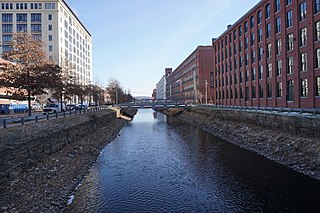
Lawrence is a city located in Essex County, Massachusetts, United States, on the Merrimack River. At the 2020 census, the city had a population of 89,143. Surrounding communities include Methuen to the north, Andover to the southwest, and North Andover to the east. Lawrence and Salem were the county seats of Essex County, until the state abolished county government in 1999. Lawrence is part of the Merrimack Valley.

Andover is a town in Essex County, Massachusetts, United States. It was settled in 1642 and incorporated in 1646. At the 2020 census, the population was 36,569. It is located 20 miles (32 km) north of Boston and 4 miles (6.4 km) south of Lawrence. Part of the town comprises the census-designated place of Andover. It is twinned with its namesake: Andover, Hampshire, England.
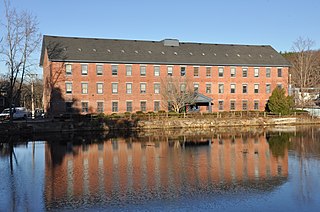
Ballardvale is a village located within the boundaries of the town of Andover, Essex County, Massachusetts, United States. Growing originally in the 19th century around mills located on the Shawsheen River, the village is a local historic district, boasting many varieties of historic architecture and a rich industrial heritage.
Shawsheen Indians were a United States soccer club based in Andover, Massachusetts during the early 1920s.
The American Woolen Company is a designer, manufacturer and distributor of men’s and women’s worsted and woolen fabrics. Based in Stafford Springs, Connecticut, the company operates from the 160-year-old Warren Mills, which it acquired from Loro Piana SpA in June 2014.

William Madison Wood was an American textile mill owner of Lawrence, Massachusetts who was considered to be an expert in efficiency. He made a good deal of his fortune through being hired by mill owners to turn around failing mills and was despised by organized labor.

Andover station is an MBTA Commuter Rail station in Andover, Massachusetts. It serves the Haverhill Line. The station has one platform with a mini-high platform for handicapped accessibility serving one track, while the second track lacks a platform. The previous station building, used from 1907 to 1959, is still extant; it was added to the National Register of Historic Places in 1982 as Third Railroad Station.

The Crystal Lake Falls Historic District, also known as the Brick Kingdom, is a historic industrial and residential area in Barton, Vermont, United States. It is located along Water Street and Main Street, roughly paralleling Willoughby Brook, whose waters powered the area's industries. It was added to the U.S. National Register of Historic Places on August 7, 1994.

Mill Conversion or mill rehab is a form of adaptive reuse in which a historic mill or industrial factory building is restored or rehabilitated into another use, such as residential housing, retail shops, office, or a mix of these non-industrial elements (mixed-use).

The Andover Village Industrial District encompasses one of the 19th century industrial mill villages of Andover, Massachusetts known locally as "The Village". The growth of this village contributed to the decision in the 19th century to separate the more rural area of North Andover from the town. It is centered on a stretch of the Shawsheen River between North Main Street on the east and Moraine Street on the west. Most of the district's properties lie on Stevens Street, Red Spring Road, Shawsheen Road, and Essex Street, with a few properties also located on adjacent roads.

Arden is a historic estate at 276 N. Main Street in Andover, Massachusetts, United States. It was the home of two of Andover's most important mill owners, John Dove and William Madison Wood.

The Ballardvale District in Andover, Massachusetts, encompasses the historic mill village of Ballardvale in the northwestern part of the town. It is centered on the crossing the Shawsheen River by Andover Street, and includes buildings on High Street, Center Street, and other adjacent roads on both sides of the river. The district was listed on the National Register of Historic Places in 1982.

The Machine Shop Village District is a historic district roughly bounded by Main, Pleasant, Clarendon, Water, 2nd Streets, and B&M Railroad in North Andover, Massachusetts. The district encompasses a well-preserved former textile mill village developed in the mid-19th century, with a variety of worker and upper-class housing, and two historic mill complexes. It was added to the National Register of Historic Places in 1982.

The North Canal Historic District of Lawrence, Massachusetts, encompasses the historic industrial heart of the city. It is centered on the North Canal and the Great Stone Dam, which provided the waterpower for its many mill complexes. The canal was listed on the National Register of Historic Places in 1975, while the district was first listed in 1984, and then expanded slightly in 2009.
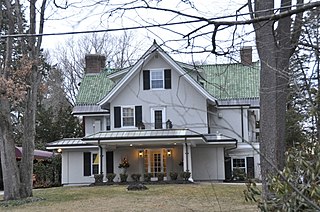
Orlando is the historic estate of William M. Wood Jr. in Andover, Massachusetts. Wood's father, William Madison Wood, was president and part owner of the American Woolen Company, whose home was the Arden estate next door to where Orlando was built. William M. Wood Jr.'s mother was Ellen Ayer Wood, the daughter of Frederick Ayer. Orlando is a distinctive Spanish Mission style mansion of 2.5 stories, with a green tile roof. The house was a wedding gift to Wood and his new wife, Edith Goldsborough Robinson, from his parents. The house was begun in 1916 and completed in 1917 to a design by architect Perley F. Gilbert, an Andover native who was then practicing in Lowell. The house's locally unusual Spanish Colonial-inspired architecture may have been influenced by the Wood family's summers in Florida.

The American Woolen Company Townhouses are a collection of brick townhouses built c. 1907 by the American Woolen Company in Lawrence, Massachusetts. They were part of a program of company-built housing between 1906 and 1910 that included the nearby American Woolen Mill Housing District. The townhouses are located on a series of short streets off Market Street in South Lawrence. A historic district comprising these six buildings was listed on the National Register of Historic Places in 2012.
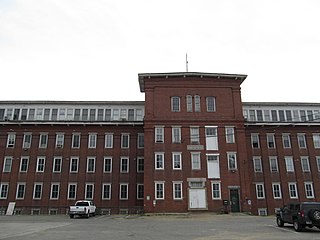
The Salmon Falls Mill Historic District encompasses a historic mill complex on Front Street in Rollinsford, New Hampshire. The complex includes four major structures and seven smaller ones, on about 14 acres (5.7 ha) of land along the Salmon Falls River. They were built between about 1840 and the mid-1860s, and have an unusual architectural unity, for additions made to the buildings were done with attention to matching design elements from the existing structures. The Number 2 Mill, built in 1848, was an early location where a turbine was used instead of a waterwheel to provide power to the mill machinery. The district was listed on the National Register of Historic Places in 1980.
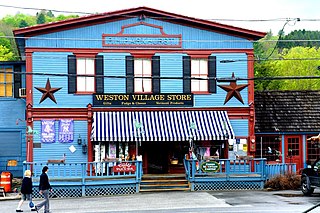
The Weston Village Historic District encompasses the town center and principal village of Weston, Vermont. Centered on Farrar Park, which serves as the town green, it includes a diversity of architectural styles from the late 18th century to about 1935, and includes residential, civic, commercial, industrial and religious buildings. It was listed on the National Register of Historic Places in 1985.
The Smith & Dove Co. spun flax into thread and twine for products such as shoes, sail cloth and carpets in mills in Andover, Massachusetts, from 1864 until 1927, when the company was sold to Ludlow Manufacturing.


















